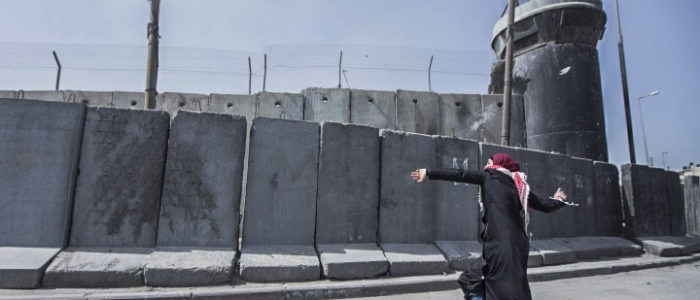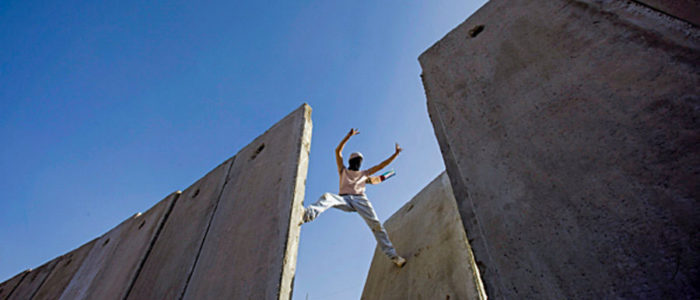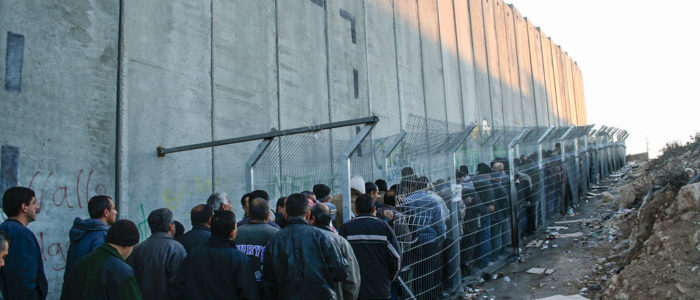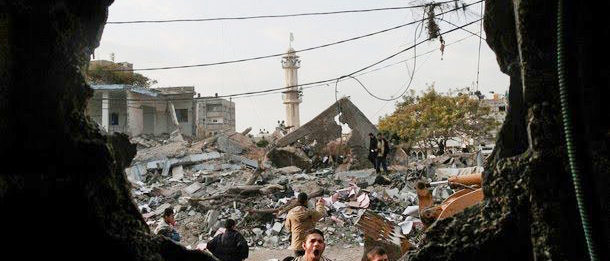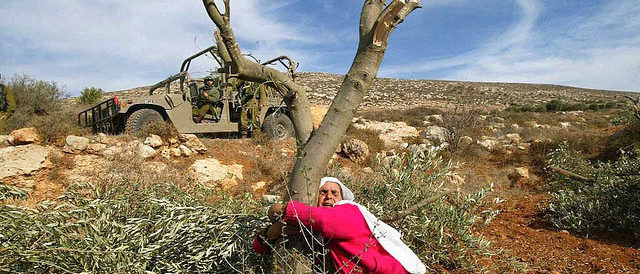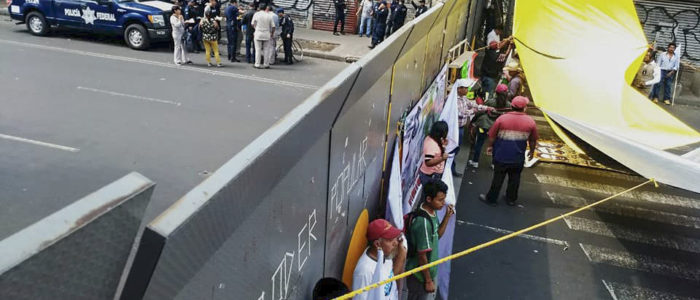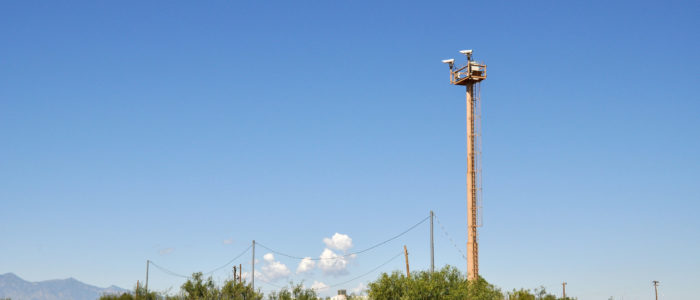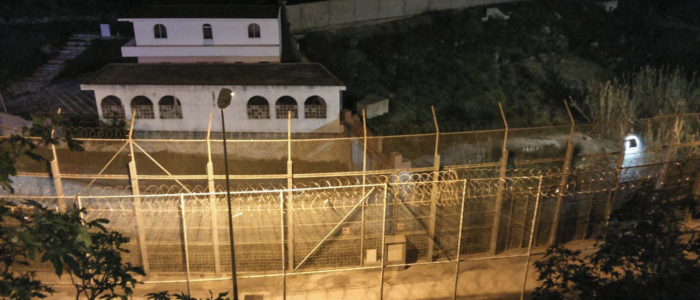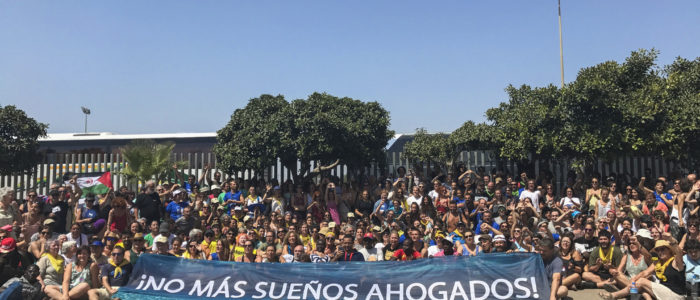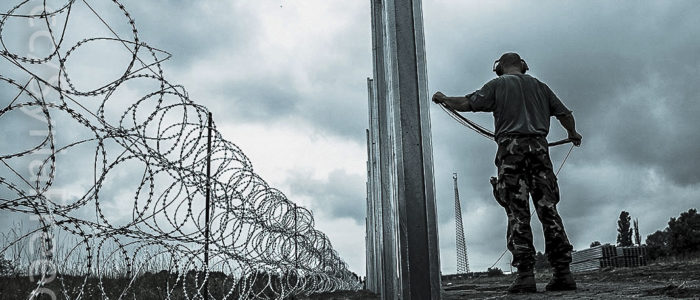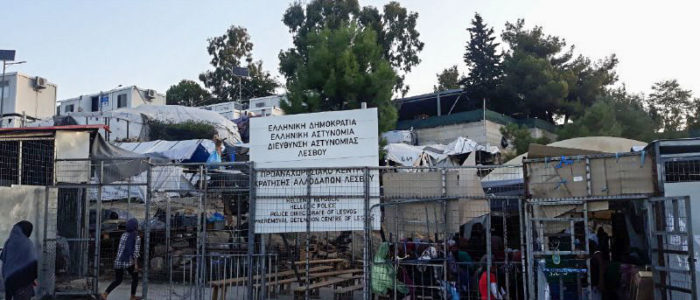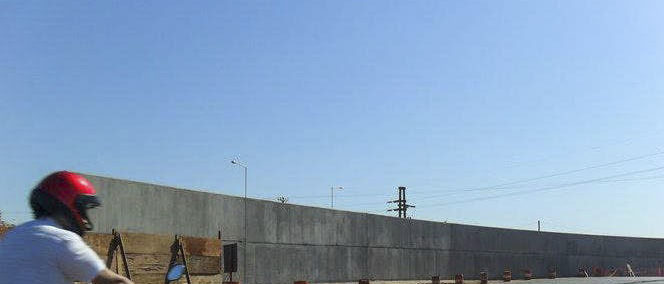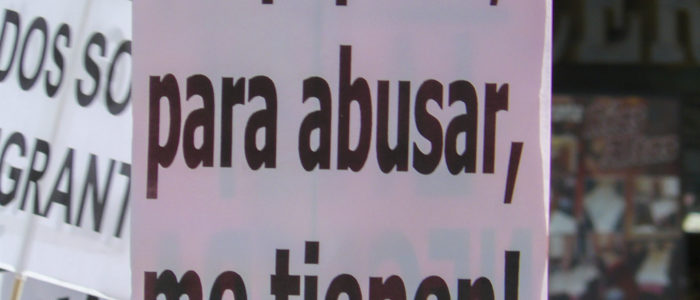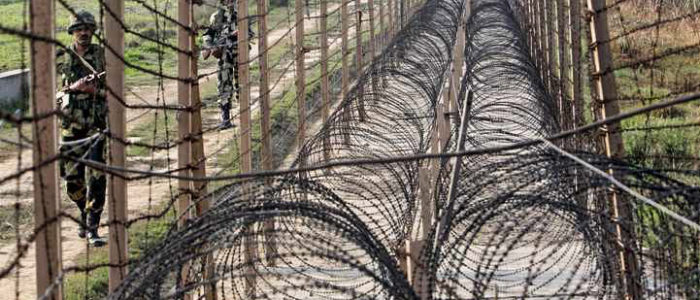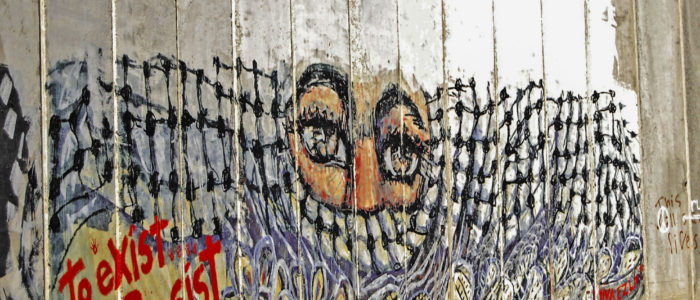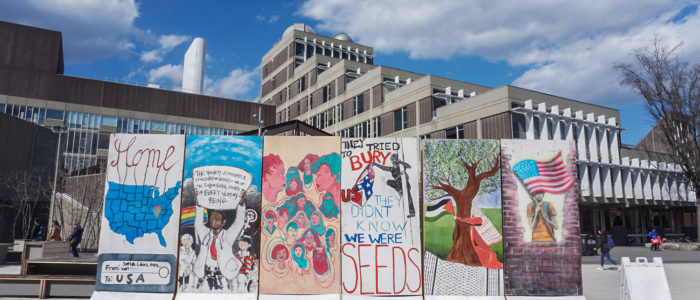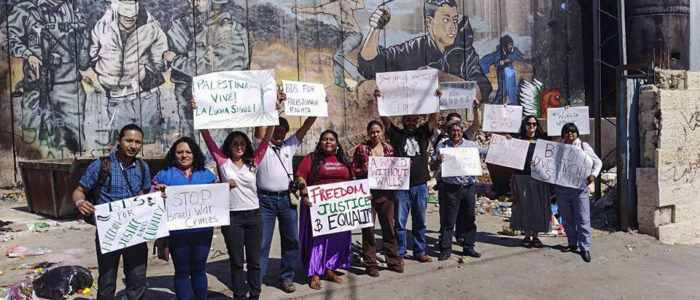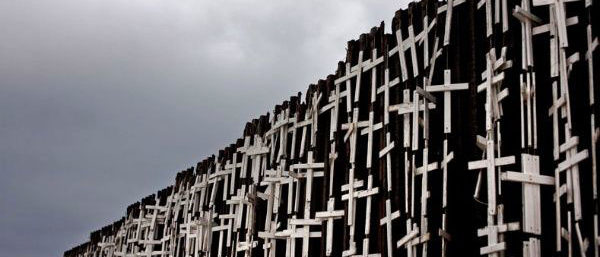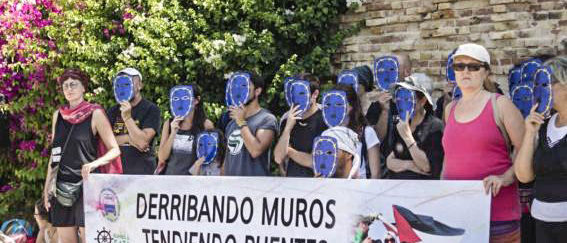The U.S. Border Patrol and an Israeli military contractor are putting a Native American reservation under “PERSISTENT surveillance”
Border surveillance tower of the United States in Naco, Arizona. 18 September 2009. (Credits: Jonathan McIntosh.)
Originally published on 25 August2019. Republished with permission from The Intercept, an award-winning nonprofit news organization dedicated to holding the powerful accountable through fearless, adversarial journalism. Sign up for The Intercept’s Newsletter.
On the southwestern end of the Tohono O’odham Nation’s reservation, roughly 1 mile from a barbed-wire barricade marking Arizona’s border with the Mexican state of Sonora, Ofelia Rivas leads me to the base of a hill overlooking her home. A U.S. Border Patrol truck is parked roughly 200 yards upslope. A small black mast mounted with cameras and sensors is positioned on a trailer hitched to the truck. For Rivas, the Border Patrol’s monitoring of the reservation has been a grim aspect of everyday life. And that surveillance is about to become far more intrusive.
The vehicle is parked where U.S. Customs and Border Protection will soon construct a 160-foot surveillance tower capable of continuously monitoring every person and vehicle within a radius of up to 7.5 miles. The tower will be outfitted with high-definition cameras with night vision, thermal sensors, and ground-sweeping radar, all of which will feed real-time data to Border Patrol agents at a central operating station in Ajo, Arizona. The system will store an archive with the ability to rewind and track individuals’ movements across time — an ability known as “wide-area persistent surveillance.”
CBP plans 10 of these towers across the Tohono O’odham reservation, which spans an area roughly the size of Connecticut. Two will be located near residential areas, including Rivas’s neighborhood, which is home to about 50 people. To build them, CBP has entered a $26 million contract with the U.S. division of Elbit Systems, Israel’s largest military company.1
Tohono O’odham people used to move freely across these lands, Rivas says, but following years of harassment by Border Patrol agents, many are afraid to venture far from their homes.
“Now we won’t be able to go anywhere near here without the big U.S.-Israeli eyes monitoring us, watching our every move,” she says.
Fueled by the growing demonization of migrants, as well as ongoing fears of foreign terrorism, the U.S. borderlands have become laboratories for new systems of enforcement and control. Firsthand reporting, interviews, and a review of documents for this story provide a window into the high-tech surveillance apparatus CBP is building in the name of deterring illicit migration — and highlight how these same systems often end up targeting other marginalized populations as well as political dissidents.
The towers on Tohono O’odham land are part of a surge in wide-area persistent surveillance systems across the borderlands. Elbit Systems of America has already built 55 integrated fixed towers in southern Arizona, which company executives say cover 200 linear miles. According to information provided by a CBP spokesperson, the agency has also deployed 368 smaller surveillance towers, known as RVSS towers, in areas ranging from south of San Diego to the Rio Grande Valley, as well as along parts of the U.S.-Canadian border.
Civil liberties advocates and academics have pointed out the heightened abuses and increased migrant suffering that have resulted from the new state-of-the-art surveillance gear. According to Jay Stanley, senior policy analyst with the American Civil Liberties Union’s Speech, Privacy, and Technology Project, the spread of persistent surveillance technologies is particularly worrisome because they remove any limit on how much information police can gather on a person’s movements. “The border is the natural place for the government to start using them, since there is much more public support to deploy these sorts of intrusive technologies there,” he said.
In February, Congress allocated $100 million for integrated fixed towers and mobile surveillance systems, a sign that the towers may soon expand to new locations.
According to Bobby Brown, senior director of Customs and Border Protection at Elbit Systems of America, the company’s ultimate goal is to build a “layer” of electronic surveillance equipment across the entire perimeter of the U.S. “Over time, we’ll expand not only to the northern border, but to the ports and harbors across the country,” Brown said in an interview with The Intercept. “There’s a lot to be done.”
Building the virtual wall
Long before President Donald Trump called for the construction of a “big, beautiful wall” along the U.S.-Mexico border, there was the idea of a “virtual wall.” In 2006, Congress authorized the construction of 700 miles of fencing to be accompanied by a vast buildup of surveillance equipment and border guards in more remote terrain.
A key component of that effort, known as SBINet, was canceled after five years and more than $1 billion in expenditures. In the wake of that failure, CBP turned to Elbit, based in Haifa, Israel, awarding it a $145 million contract in 2014 to develop the integrated fixed towers in southern Arizona. In addition to fixed and mobile surveillance towers, other technology that CBP has acquired and deployed includes blimps2 outfitted with high-powered ground and air radar, sensors buried underground, and facial recognition software3 at ports of entry. CBP’s drone fleet has been described4 as the largest of any U.S. agency outside the Department of Defense.
The surveillance has had an acute impact on borderland communities, including on the Tohono O’odham reservation. Drones fly overhead, and motion sensors track foot traffic. CBP checkpoints monitor people traveling between the reservation and cities such as Tucson and Phoenix. Vehicle barriers, surveillance cameras, and trucks have appeared near burial grounds and on hilltops amid ancient saguaro forests, which are sacred to people on the reservation.
Nellie Jo David, a Tohono O’odham tribal member who is writing her dissertation on border security issues at the University of Arizona, says many younger people who have been forced by economic circumstances to work in nearby cities are returning home less and less, because they want to avoid the constant surveillance and harassment. “It’s especially taken a toll on our younger generations.”
Border militarism has been spreading worldwide owing to neoliberal economic policies, wars, and the onset of the climate crisis, all of which have contributed to the uprooting of increasingly large numbers of people, notes Reece Jones, a University of Hawaii-Manoa geography professor who studies borders and migration.
“The build-up started in the 1990s, but particularly after the declaration of the war on terror, funding began flowing into the border security sector in all these different places around the world,” Jones says. The number of fortified borders worldwide soared from 15 to 70 between 2000 and 2015, he added.
This militarization has, in turn, created new profit opportunities for technology and defense firms. In the U.S., leading companies with border security contracts include long-established contractors such as Lockheed Martin in addition to recent upstarts such as Anduril Industries, founded by tech mogul Palmer Luckey to feed the growing market for artificial intelligence and surveillance sensors — primarily in the borderlands.
Elbit Systems has frequently touted a major advantage over these competitors: the fact that its products are “field-proven” on Palestinians. 5The company built surveillance sensors for Israel’s separation barrier through the West Bank6, which has been deemed illegal under international law, as well as around the Gaza Strip and on the northern border with Lebanon7 and Syria.
Elbit is also one of the main contractors on a new kind of underground wall,8 still under construction, around the blockaded Gaza Strip. Elbit’s drones patrol the Mediterranean Sea9 as part of the European Union’s bid to seal off access to migrants from North Africa, and it has provided its technologies to militaries in Australia, Africa, Asia, Central America, and South America.
Elbit’s contract to deploy IFTs on the Tohono O’odham reservation, which the company announced on June 26,10 follows several years of contentious debate within the tribal nation, with those living near tower construction sites voicing strident opposition. Two years ago, CBP released a study claiming that integrated fixed tower construction wouldn’t cause archaeological, environmental, or community harm. The agency also decreased the number of proposed towers and redesigned their bases so they wouldn’t extend underground. The Tohono O’odham legislative council unanimously approved the towers on March 22, citing the importance of helping Border Patrol agents stem cross-border drug trafficking.
In an interview with the Los Angeles Times,11 Verlon Jose, then-tribal vice chair, said that many nation members calculated that the towers would help dissuade the federal government from building a border wall across their lands. The Tohono O’odham are “only as sovereign as the federal government allows us to be,” Jose said. A Border Patrol spokesperson told the newspaper, however, that the IFTs did not eliminate the need for a wall.
The Tohono O’odham Nation’s current chair and vice chair did not respond to requests for comment on this story.
In a statement to The Intercept, CBP spokesperson Meredith Mingledorff said Elbit’s integrated fixed towers enhance Border Patrol agents’ safety at a low cost. “IFTs are a ‘force multiplier’ that enables one agent to monitor various different sites remotely from a secure location,” she said. “They are low cost of maintenance and allow for greater efficiency of law enforcement operations, as we can better deploy resources depending on the type of incursion that is detected by the technology.”
Elbit’s showcase
On a sweltering afternoon in early April, Elbit Systems of America executives showcased their latest border surveillance products at a company testing facility in Marana, Arizona, roughly 20 miles northwest of downtown Tucson. The event centered around a live demonstration of the IFT command and control system, known as TORCH. The system, which Elbit originally developed for the Israel Defense Forces, is used to monitor people’s movements along Israel’s border and separation walls. Now, it is also used by the Border Patrol at command centers across southern Arizona.
The event also served as a showcase for Elbit’s high-level political support. U.S. Sen. Martha McSally’s deputy state director was on hand, as was Ron Colburn, a former national deputy chief of the Border Patrol and current Elbit adviser. Colburn is perhaps best known for an appearance on Fox News last November12 defending the Border Patrol’s use of tear gas and pepper spray on migrant caravan participants near Tijuana, who had attempted to cross into the United States. Pepper spray “is natural,” Colburn said, before adding, “You could actually put it on your nachos and eat it.”
Joel Friederich, Elbit Systems of America’s vice president of public safety and homeland security, stood near a wall-sized monitor flanked by a pair of Elbit engineers as reporters and invited guests looked on. On the screen, a satellite map was populated with clusters of yellow and pink dots. Several smaller surrounding images displayed live feeds from the various video cameras and radar sensors adorning a demonstration tower on site. “This can be zoomed in for many, many miles,” Friederich explained.
An engineer clicked on one of the yellow dots, zooming in on one of the video feeds. Suddenly, several cars inching across U.S. Interstate 10 came distinctly into view. He zoomed in further, and the screen settled on a patch of shrubs adjacent to a roadway, close enough that the bright green, swaying tips of the creosote bushes were visible, though they were well over a mile away. The operating system uses artificial intelligence to assign an icon representing a human, vehicle, or animal, allowing Border Patrol agents to determine if something moving across the desert is a potential “item of interest,” Friederich noted. That item could include “anyone carrying a weapon or a backpack, or anyone in a large group.”
For Elbit, the holy grail of border surveillance is to ensure that no person can escape TORCH’s ability to track them across time and space in a given area. If one of the “items” ducks into a bush, the system can track them using a long-range infrared camera. For night operations, the towers have laser illuminators. A pick-up truck that can be remotely operated with a surveillance tower and 6-mile camera range is also able to feed data to TORCH in case someone ducks behind a mountain or into a ravine. The company is currently marketing the truck to CBP.
In 2016, Israel became the first country to deploy autonomous vehicles in a border area, which were also created by Elbit.13
Leading Democrats have argued for the development of an ever-more sophisticated border surveillance state as an alternative to Trump’s border wall. “The positive, shall we say, almost technological wall that can be built is what we should be doing,” House Speaker Nancy Pelosi said in January.
But for those crossing the border, the development of this surveillance apparatus has already taken a heavy toll. In January, a study published by researchers from the University of Arizona and Earlham College14 found that border surveillance towers have prompted migrants to cross along more rugged and circuitous pathways, leading to greater numbers of deaths from dehydration, exhaustion, and exposure.
Maren Mantovani, international relations coordinator of Stop the Wall, a Palestinian coalition that opposes Israel’s walls in the Palestinian territories and elsewhere, has tracked Elbit’s activities for nearly two decades. The company’s business success reflects the central role borders are playing in an emerging global surveillance society, she says. “Walls are not only a question of blocking people from moving, but they are also serving as borders or frontiers between where you enter the surveillance state,” she said. “The idea is that at the very moment you step near the border, Elbit will catch you. Something similar happens in Palestine.”
At the 13th annual Border Security Expo in San Antonio, Texas, two weeks prior to the event in Arizona, Friederich said in an interview with The Intercept that Elbit was preparing to bid on a contract to build integrated fixed towers on the U.S.-Canadian border and was eyeing opportunities in the Rio Grande Valley.
According to Brown, the Elbit senior director, the company’s border surveillance work will proceed indefinitely regardless of the construction of Trump’s border wall. “Border security has always been a three-legged stool — manpower, infrastructure, and technology,” he said. “Infrastructure being the wall. Technology being the towers, the mobile systems, the ground detection such as sensors. We’re going to keep busy no matter what.”
Mission creep
CBP is by far the largest law enforcement entity in the U.S., with 61,400 employees and a 2018 budget of $16.3 billion — more than the militaries of Iran, Mexico, Israel, and Pakistan. The Border Patrol has jurisdiction 100 miles inland from U.S. borders,15 making roughly two-thirds of the U.S. population theoretically subject to its operations, including the entirety of the Tohono O’odham reservation.
The agency has received considerable criticism for its often-brutal treatment of migrants. But a large percentage of its operations involve routine police work. Between 2013 and 2016, for example, roughly 40 percent of Border Patrol seizures16 at immigration enforcement checkpoints involved 1 ounce or less of marijuana confiscated from U.S. citizens. Yet not as much attention has been paid to how the agency uses its sprawling surveillance apparatus for purposes other than border enforcement.
In 2017, as companies built prototypes for Trump’s border wall in San Diego, CBP stationed one of its RVSS towers nearby to monitor political opposition, citing the “emerging threat of demonstrations,” records show. The tower deployment lasted for eight months beginning in September 2017, according to a federal contract tender posted online.17 The only significant demonstration to occur was a peaceful rally that greeted Trump in March 2018 as he conducted a photo-op tour of the wall prototypes.
Making use of the border surveillance tower to monitor political protests was a seamless transition, according to the contract tender. “CBP concluded that the RVSS relocatable tower solution was a logical choice since placement of this RVSS tower was essentially an extension of the existing RVSS system in place along the border in San Diego, and the tower would also provide surveillance of two areas at one time,” it stated.
CBP also frequently “shares” its aircraft, including surveillance drones, with other U.S. law enforcement agencies. According to flight logs18 The Intercept obtained via the Freedom of Information Act, between July 2016 and August 2017, CBP conducted 15 drone flights for state and local police spanning 90.2 hours and an additional 53 flights for federal police agencies covering more than 200 hours. The logs provided by CBP failed to specify the locations of these flights, but additional documents obtained via public records requests suggest that CBP drone flights included surveillance of Dakota Access pipeline protests.
In a statement to The Intercept, a CBP spokesperson confirmed that North Dakota law enforcement used the agency’s drone at Standing Rock, claiming that it helped protect local police equipment from threats. “The Unmanned Aerial System (UAS) provided a video feed to the local command center, giving the sheriff’s department and state police situational awareness of the protest while minimizing the threat to their aviation personnel and assets,” the spokesperson wrote.
During the Standing Rock protests, police and private security personnel regularly justified surveillance by casting pipeline opponents as instigators of violence.19
For its part, Elbit has also marketed its surveillance equipment for use against protesters on at least one occasion, according to records The Intercept obtained via Freedom of Information requests. In November 2016, a company representative offered a system of wide-area persistent surveillance sensors to police monitoring Dakota Access pipeline opponents.20 Elbit’s description of its product, known asGroundEye, touted it as “a paradigm shift in defense and security surveillance,” owing to its “ability to move ‘Back-In-Time,’ to simultaneously track and trace the movements of one or more objects.”21
A spokesperson for the North Dakota Department of Emergency Services said the agency ultimately opted against purchasing the GroundEye system, though she declined to state a reason.
The ACLU’s Jay Stanley says that CBP’s repurposing of the surveillance tower and drones to surveil dissidents hints at other possible abuses. “It’s a reminder that technologies that are sold for one purpose, such as protecting the border or stopping terrorists — or whatever the original justification may happen to be — so often get repurposed for other reasons, such as targeting protesters.”
That potential is further underscored by a March 2018 email exchange, obtained via open records requests, that shows a high-ranking Border Patrol officer referring to political opposition to Trump border policies as a “threat”.22 Border Patrol Agent in Charge Christopher M. Seiler, of the agency’s Rio Grande Valley sector, emailed more than 30 other supervisory agents to invite them to a “Large Scale Protest Response Seminar.” The leader of the seminar was Paul Laney, the former sheriff of Cass County, North Dakota, who served as the leading architect of the militarized police response at Standing Rock.
“The current political climate, uptick in demonstrations and social media campaigns, along with the immigration debate almost ensure that RGV will have large scale protests,” Seiler wrote. “These protests pose a significant threat to the border, law enforcement, and our communities.”
Tohono O’odham under occupation
The impacts of the U.S. border on Tohono O’odham people date to the mid-19th century. The tribal nation’s traditional land extended 175 miles into Mexico before being severed by the 1853 Gadsden Purchase, a U.S. acquisition of land from the Mexican government.23 As many as 2,500 of the tribe’s more than 30,000 members still live on the Mexican side. Tohono O’odham people used to travel between the United States and Mexico fairly easily on roads without checkpoints to visit family, perform ceremonies, or obtain health care.
But that was before the Border Patrol arrived en masse in the mid-2000s, turning the reservation into something akin to a military occupation zone. Residents say agents have administered beatings, used pepper spray, pulled people out of vehicles, shot two Tohono O’odham men under suspicious circumstances, and entered people’s homes without warrants.
“It is apartheid here,” Ofelia Rivas says. “We have to carry our papers everywhere. And everyone here has experienced the Border Patrol’s abuse in some way.”
Nellie Jo David says the constant surveillance has profoundly disrupted the cultural fabric of the Tohono O’odham people, alongside other federal government intrusions like the Barry M. Goldwater Air Force Range, built adjacent to the reservation in the 1940s.
“The towers are just one more target on our culture and way of life,” David says. “We can’t really have the same ceremonies if there are going to be eyes on us, coming from an operational control room with likely a white male agent looking into what it is to be O’odham.”
Although the Tohono O’odham tribal council has supported the integrated fixed towers, the majority of people living near future construction sites have vocally opposed them. Two of the towers are slated for the district of Gu-Vo, or “Big Pond,” where Rivas resides, the westernmost of 11 districts on the reservation. The Gu-Vo governing council passed a resolution against the towers in 2017, citing firm opposition to residents placed under persistent surveillance and a desire to protect sacred burial sites, ceremonial areas, and harvesting grounds.
In the process of opposing the towers, Tohono O’odham people have developed common cause with other communities struggling against colonization and border walls. David is among numerous activists from the U.S. and Mexican borderlands who joined a delegation to the West Bank in 2017, convened by Stop the Wall, to build relationships and learn about the impacts of Elbit’s surveillance systems.
“I don’t feel safe with them taking over my community, especially if you look at what’s going on in Palestine — they’re bringing the same thing right over here to this land,” she says. “The U.S. government is going to be able to surveil basically anybody on the nation.”
Originally published on 25 August 2019. Translated from English and republished with permission from The Intercept, an award-winning nonprofit news organization dedicated to holding the powerful accountable through fearless, adversarial journalism. Sign up for The Intercept’s Newsletter.
1 “U.S. Customs and Border Protection, Tohono O’odham Nation Agree On Border Security Solution by Elbit Systems of America”, Elbit Systems of America, LLC, 26 June 2019.
2 Dave Long, “CBP’s Eyes in the Sky”, U.S. Customs and Border Protection.
3 Mark Rockwell, “CBP deploys facial recognition at the southern border”, Federal Computer Week, 21 February 2019.
4Craig Whitlock and Craig Timberg, “Patrol-border drones being borrowed by other agencies more often than previously known”, Washington Post, 14 January 2014.
5 “Advanced Border Security Solution – Operational intelligence to counter cross-border threats in real time”, Elbit Systems.
6 “Elbit Systems Wins Deal to Build Jerusalem Electronic Fence“, Reuters, Haaretz, 18 September 2002.
7 Amir Rapaport, “Sensor System to be Deployed along Israel-Lebanon Border”, IsraelDefense Magazine, 15 June 2013.
8 “Israeli official bets advances in Anti-Tunnel Technology Will Help Secure Gaza Border”, Washington Post, 6 March 2018.
9 Shoshanna Solomon, “Elbit wins drone contract for up to $68m to help monitor Europe coast”, Times of Israel, 1 November 2018.
10 “U.S. Customs and Border Protection, Tohono O’odham Nation Agree On Border Security Solution by Elbit Systems of America”, Elbit Systems of America, LLC , Cision PR Newswire, 26 June 2019.
11 Molly Hennessey-Fisk, “Arizona tribe refuses Trump’s wall, but agrees to let Border Patrol build virtual barrier”, Los Angeles Times, 9 May 2019.
12 Kate Prengel, “Ronald Colburn: 5 Fast Facts You Need to Know”, Heavy.com, 26 November 2018.
13 James Rogers, “Robot patrol: Israeli Army to deploy autonomous vehicles on Gaza border”, Fox News Channel, 1 September 2016.
14 Samuel Norton Chambers, Geoffrey Alan Boyce, Sarah Launius & Alicia Dinsmore, “Mortality, Surveillance and the Tertiary “Funnel Effect” on the U.S.-Mexico Border: A Geospatial Modeling of the Geography of Deterrence” ,Journal of Borderlands Studies, (2019)
15 “The Constitution in the 100-miles border zone”, American Civil Liberties Union.
16 “Border Patrol – Issues Related to Agent Deployment Strategy and Immigration Checkpoints”, United States Government Accountability Office, November 2017.
17 Justification for other than full and open competition. 41 U.S.C. 3304; FAR 6.302-2, Unusual and Compelling Urgency. Available here.
19Alleen Brown, Will Parrish, Alice Speri, “Standing Rock documents expose inner workings of ‘surveillance-industrial complex’”, The Intercept, 3 June 2017.
22 Will Parrish, “Border Patrol museum demonstrators targeted in crackdown on immigrant rights protests“, Shadowproof, 20 May 2019.
23 Tay Wiles, “A closed border gate has cut off three Tohono O’odham villages from their closest food supply.“, Pacific Standard, 7 February 2019.


